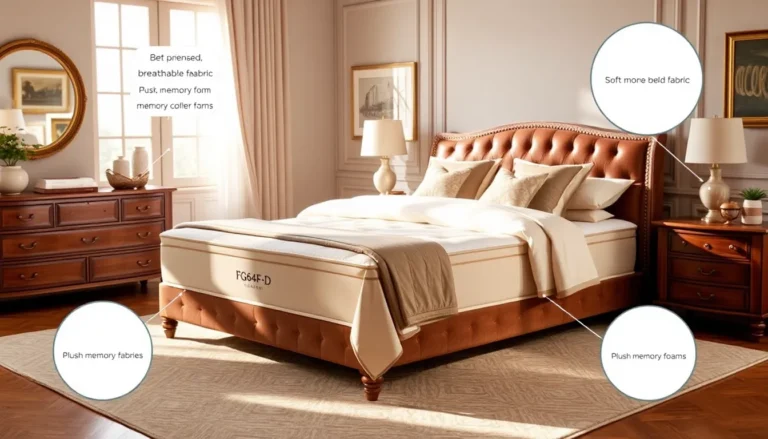In today’s fast-paced world, staying connected is as essential as your morning coffee. Imagine this: you’re at a café, your laptop’s battery is charged, but the Wi-Fi is about as reliable as a cat on a leash. Fear not! With just a few taps, your trusty iPhone can become a hotspot, giving your laptop the internet boost it desperately needs.
Table of Contents
ToggleUnderstanding Hotspot Features
Mobile hotspots provide a convenient way to share cellular data from an iPhone with other devices. Users access the internet on laptops when Wi-Fi connections are unavailable or unreliable.
What Is a Mobile Hotspot?
A mobile hotspot creates a wireless internet connection using a smartphone’s cellular data. It allows multiple devices to connect to the internet without needing a traditional Wi-Fi router. iPhones feature this capability, enabling users to turn their devices into hotspots easily. Activating this feature is often a straightforward process within the device settings. Users can control the hotspot’s name and security, ensuring a secure connection for all devices accessing the shared data.
Benefits of Using a Hotspot
Utilizing a hotspot offers significant advantages for connectivity. Instant internet access comes in handy during travel or when public Wi-Fi networks are slow or unsecured. Users can connect multiple devices, such as laptops and tablets, to the hotspot simultaneously. Enhanced security is another benefit; using a personal hotspot reduces exposure to potential cyber threats associated with public networks. Mobile hotspots also simplify online tasks like video streaming or file downloads without relying on external Wi-Fi sources. Flexibility and convenience make hot spots an essential tool for those who require consistent internet access.
Prerequisites for Connecting

Before connecting an iPhone hotspot to a laptop via Bluetooth, several prerequisites must be met. Ensure the devices are compatible and have Bluetooth capability.
Compatible Devices
iPhones running iOS 13 or later support hotspot features. Laptops should have Bluetooth functionality, with Windows 10 or macOS Mojave or newer versions preferred for smooth connectivity. Checking for updated software on both devices is wise, as this can enhance performance and reliability during the connection process. Compatibility ensures that users achieve reliable internet access without interruptions during critical tasks.
Bluetooth Settings
Activate Bluetooth on both devices before pairing them. On the iPhone, navigate to Settings, then Bluetooth, and enable the toggle. For the laptop, access Bluetooth settings through the system preference menu or control panel. Pairing is necessary for enabling connectivity. Follow prompts on both devices to establish the connection; this often involves entering a passcode. Setting up the hotspot feature on the iPhone requires going to Settings, tapping Personal Hotspot, and enabling the feature to share cellular data effectively.
Step-by-Step Guide
Connecting an iPhone hotspot to a laptop via Bluetooth is a straightforward process. Follow these steps for a seamless experience.
Preparing Your iPhone
Start by enabling the hotspot feature on the iPhone. Navigate to the Settings app, tap on “Personal Hotspot,” and toggle on “Allow Others to Join.” Ensure cellular data is active as this will fuel the hotspot connection. Customize the Wi-Fi password for added security if needed. Bluetooth should also be turned on from the “Bluetooth” menu in Settings. Checking for updates strengthens performance, so verify that the iPhone is running iOS 13 or later.
Configuring Your Laptop
The next step involves preparing the laptop for Bluetooth pairing. Open the Bluetooth settings through the control panel for Windows or System Preferences for macOS. Turn on Bluetooth if it’s off, then ensure the device is discoverable. Search for available Bluetooth devices, which will be essential for pairing with the iPhone. Confirm the laptop’s operating system is compatible, ideally running Windows 10 or macOS Mojave or later. Updating the operating system enhances connectivity and security.
Establishing the Bluetooth Connection
The connection process begins with pairing the two devices. Locate the iPhone in the laptop’s Bluetooth settings and select it to initiate pairing. Enter the passcode displayed on the iPhone when prompted on the laptop screen. Successful pairing leads to a confirmation, indicating the iPhone is now available as a network. Next, enable the internet connection by selecting the newly connected device in the laptop’s network settings. Data sharing is now active, allowing internet access via the iPhone hotspot.
Troubleshooting Common Issues
Users may encounter various issues when connecting an iPhone hotspot to a laptop via Bluetooth. By addressing these common problems, they can maintain a seamless internet connection.
Connection Failures
Connection failures are a frequent issue. Users should first ensure both devices are discoverable. Checking that Bluetooth is enabled on both the iPhone and laptop enhances visibility. Additionally, confirming that the iPhone’s hotspot feature is active prevents connection barriers. Sometimes, restarting both devices can also rectify underlying problems. Outdated software may cause disruptions, so updating to the latest version is crucial. Lastly, checking for interference from other Bluetooth devices can help streamline the connection process.
Speed Problems
Speed problems might arise during usage. Users should check their cellular signal strength as weak signals directly affect hotspot performance. Verifying that no other devices are actively using the hotspot ensures optimal speed for the laptop. Prioritizing lightweight applications while connected can improve overall usability. Users may also want to move closer to the iPhone to reduce distance-related slowdowns. Switching off unnecessary apps on the laptop can maximize available bandwidth for critical tasks. Lastly, ensuring that the iPhone is not running low on battery helps maintain a stable connection.
Connecting an iPhone hotspot to a laptop via Bluetooth is a practical solution for staying online when traditional Wi-Fi isn’t available. By following the outlined steps users can easily set up a reliable internet connection that enhances productivity and convenience.
With the right preparation and troubleshooting tips in hand users can navigate potential issues and enjoy seamless connectivity. Embracing mobile hotspots not only ensures users remain connected but also empowers them to tackle online tasks with confidence no matter where they are.



